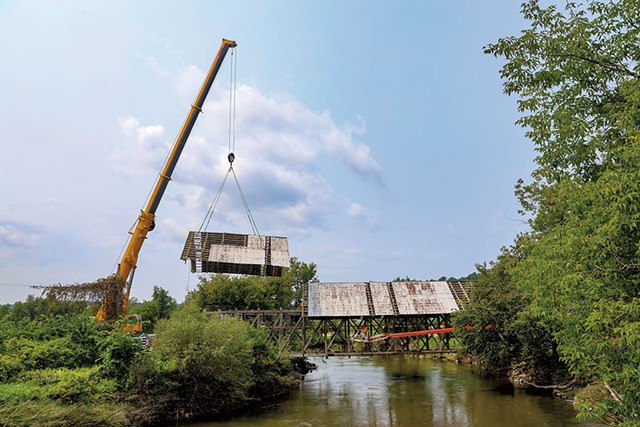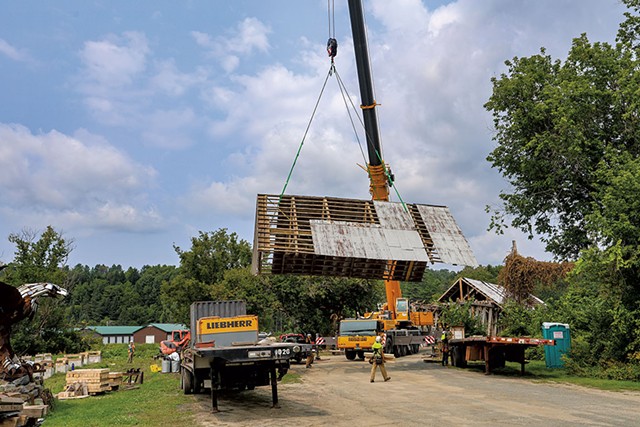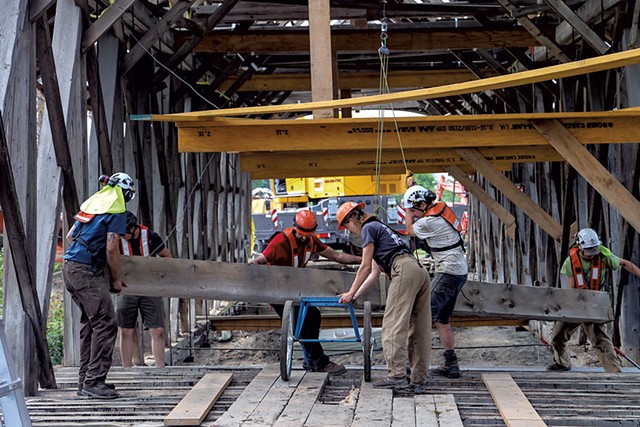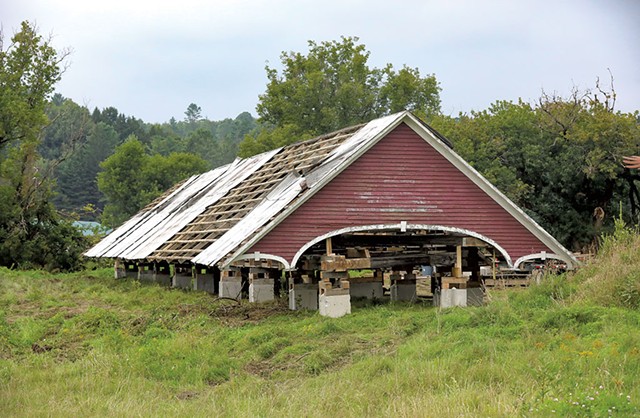
- Steve Legge
- Dismantling the Sanborn Covered Bridge
As the remnants of Tropical Storm Debby approached Vermont earlier this month, Lyndon officials moved quickly to save the iconic Sanborn Covered Bridge from being swept down the Passumpsic River.
The town had planned to refurbish the bridge in the coming year and create a small park next to it. Instead, spooked by the July 30 flooding that washed out roads and destroyed homes in Lyndon and other Northeast Kingdom towns, officials hired a team of timber framers to dismantle the structure, which was built around 1860.
The day before Debby arrived, Miles Jenness, who owns Vermont Heavy Timber in Huntington, stripped the siding off the town-owned bridge. That would allow water to flow through the structure if it got that high. He also anchored the span to the riverbanks with cables.
"We were focused on doing it quickly, especially now that the bridge was in a weakened state and another large flood could put it in the river," he said.
As it turned out, the tail end of Debby, which came through on August 9, did not cause more flooding in Lyndon. Nonetheless, last week Jenness and a crew of about a dozen people set up their equipment on the riverbank and took the wooden bridge apart by hand and crane, labeling each piece. A small rowboat was tucked under the span, and two life preservers provided a pop of color — orange — on the weathered structure. The brown Passumpsic, back at its normal levels, flowed quietly below. Although the bridge was functional, it had not been used by cars for a long time.

- Steve Legge
- A crane removing the Sanborn Covered Bridge's roof
A visiting timber framer from France worked without pay on Jenness' crew, removing individual beams from the floor and stacking them on the grass of the riverbank. A crane slowly lifted the large timbers off the 120-foot-long span.
"Mother Nature kind of speeded up the plans to work on this bridge," said Bill Caswell, president of the National Society for the Preservation of Covered Bridges. He had driven two hours from Hillsboro, N.H., to watch the work last Thursday.
For now, the bridge pieces will sit on tall concrete blocks on the riverbank, sheltered by the roof, which was also removed with a crane. The restoration project, meanwhile, has been delayed indefinitely.
Jenness offered to help in early August after he saw a photo of the bridge with floodwaters reaching its deck. A veteran of historical reconstruction, Jenness is one of several timber-frame carpenters who worked in France for six months last year on the restoration of Notre-Dame de Paris, the medieval cathedral that was damaged by fire in 2019.
He told Seven Days that others in the timber-framing community had been calling to ask if they could help out in Lyndon, too. They were drawn to the complexity of the job, he said, and the historical significance of the structure, which had never been dismantled before — though it was moved across town on wheels in 1960.
"Covered bridges are pretty special; there aren't many of them left," said Jenness, who monitors them as a member of the Vermont Covered Bridge Society.
Jenness' colleague Will Wallace-Gusakov, who also worked on Notre-Dame de Paris last year, lent a hand for a few days. Wallace-Gusakov, who owns a small timber-framing company in Lincoln, said his crew stayed on-site for the whole week.
"Everyone was excited at the prospect of helping to save a cool landmark," he said.
Timber-frame building is a centuries-old method that uses large beams and mortise and tenon joinery, in which a wooden tenon at the end of one beam is fitted into a hole, or mortise, on another beam. The method creates expansive interiors that, when left uncovered, show the engineering and artistry behind the structure.

- Steve Legge
- Workers removing the Sanborn Covered Bridge pieces
Jenness has been studying and restoring timber-frame buildings such as barns, churches and bridges for years.
"It's not just about making money for me," he said. "I really love the historic structures and the window they open into the history of the time they were built and used most."
The Sanborn bridge is a classic timber-frame structure, joined with wooden trunnels, or pegs. The span connected a town road for 100 years before it was replaced in 1960 with a more modern bridge, said Carol Fisher, whose mother-in-law, Harriet Fisher, was the town historian for years. Fisher said a pair of local businessmen bought the old covered bridge for $1 and paid to move it on wheels across town. She was 14 but remembers the day.
"The streets were lined with people; the parking lots were full," she said.
Since then, the bridge has spanned the Passumpsic near the well-traveled intersection of Vermont routes 5 and 114, serving more as a local attraction than a way to get across the river.
In the 1970s, the highly visible Sanborn was enclosed and housed a real estate office; it served as a popular setting for prom photos. A bait and tackle shop also used the structure at one point, Fisher said. Snowmobilers, walkers and bikers detoured to pass through it.
Retired art teacher Martha Elmes, who operates the Satellite Gallery & Community Space in Lyndonville, held a pop-up art exhibit on the bridge last summer that featured photographs of townspeople and audio recordings of their stories. She was planning a dinner on the span this fall, she said.
"I didn't know this was going to happen so soon," she said of the deconstruction work.
The wooden bridge has often been battered by severe weather, including major 19th-century floods. But a deluge in mid-July left it particularly vulnerable by undermining the abutments on one side of the bridge. Posts dangled from the structure, which had a significant new lateral bend.
Later in July, a storm dumped a record eight inches of rain on the region, badly damaging homes and roads — though not the bridge.
Predictions that the remnants of Debby would hit Vermont just days after the July 30 flood sparked fears that the bridge would be destroyed.
Caswell, from New Hampshire, took the day off from his job to watch the dismantling. He said he and his wife have visited nearly all of the 1,000 covered bridges in North America. He knew the story of the Sanborn bridge well, noting that its actual construction date, estimated to be 1858 in some histories, remains unknown.
With 100, Vermont has more covered bridges per capita than any other state, Caswell said. Lyndon, which has five, calls itself the "Covered Bridge Capital of the Northeast Kingdom."

- Steve Legge
- The Sanborn Covered Bridge pieces after being dismantled
Asked last Thursday about plans for the Sanborn, public officials in Lyndon said they're still engaged in flood response after the succession of storms over the past six weeks. The rainfall on July 30 swamped parts of downtown, including two businesses — the Miss Lyndonville Diner and the Village Sport Shop — that have announced they won't reopen.
It also destroyed six houses and damaged several more. Many rural roads are still closed or down to one lane, former Lyndon state representative Marty Feltus said.
"The poor town crews are working like crazy to get the roads back together and the electricity back together," Feltus said.
Feltus, who is leading a flood study for the town's hazard mitigation committee, said there's no consensus yet on the bridge's future. Jenness would like to rebuild it on the same spot — although higher — and that's the solution Feltus prefers, too. But she said some people in town are worried that the concrete abutments obstruct the river flow, thereby increasing the flood risk. They want the bridge to be moved to a field, away from the river, Feltus said.
She's trying to keep an open mind.
"Now is the time to think about maybe doing it slightly differently from what we have planned," Feltus said.









Comments
Comments are closed.
From 2014-2020, Seven Days allowed readers to comment on all stories posted on our website. While we've appreciated the suggestions and insights, right now Seven Days is prioritizing our core mission — producing high-quality, responsible local journalism — over moderating online debates between readers.
To criticize, correct or praise our reporting, please send us a letter to the editor or send us a tip. We’ll check it out and report the results.
Online comments may return when we have better tech tools for managing them. Thanks for reading.